In this article, you will learn 7 Actionable and Proven techniques to create stunning birds-in-flight images.
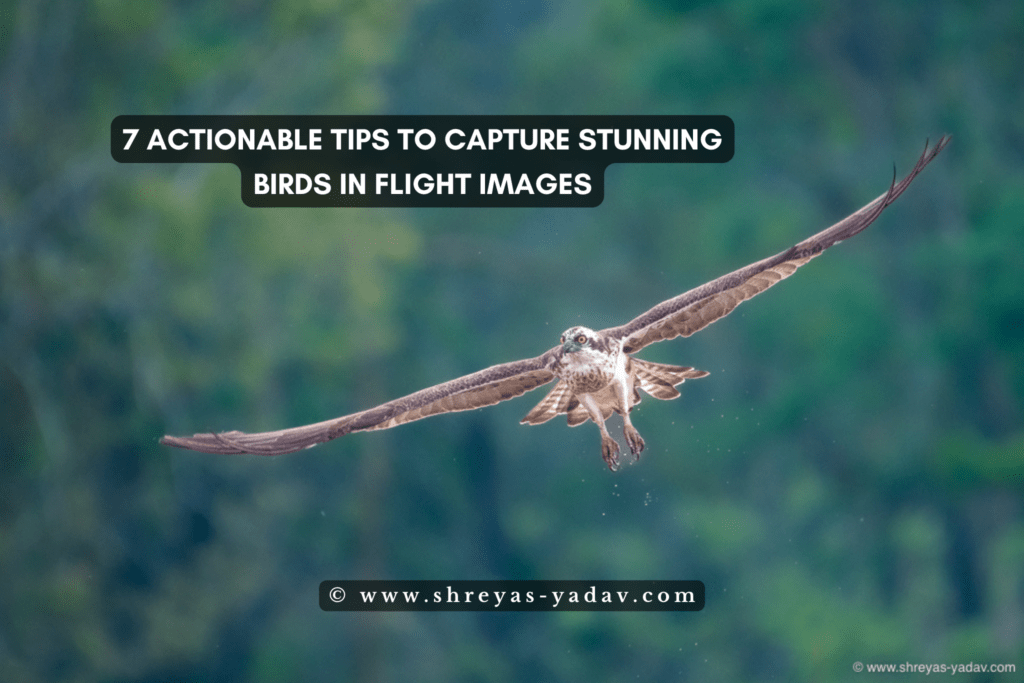
Why is the bird out of focus in my images? Why are my birds in flight images are blur?
What’s wrong with the exposure? How can I get sharp birds wings and eyeballs in my Birds in Flight images?
Does this sound familiar to you? Do you find these challenges while photographing Birds In Flight?
Well, it’s time to take your Birds In Flight Images to the next level
With the exact technique, you can make your Birds In Flight Images awesome.
Photographing Birds In Flight is a mix of Art and photographic technique. Once you learn the right photographic techniques, the quality of your images will skyrocket!
Today, in this article, you will learn the exact 7 Actionable and Proven techniques to create stunning birds-in-flight images.
The best part is that you can use the techniques discussed in this article with any brand of DSLR or Mirrorless camera.
Let’s dive right in.
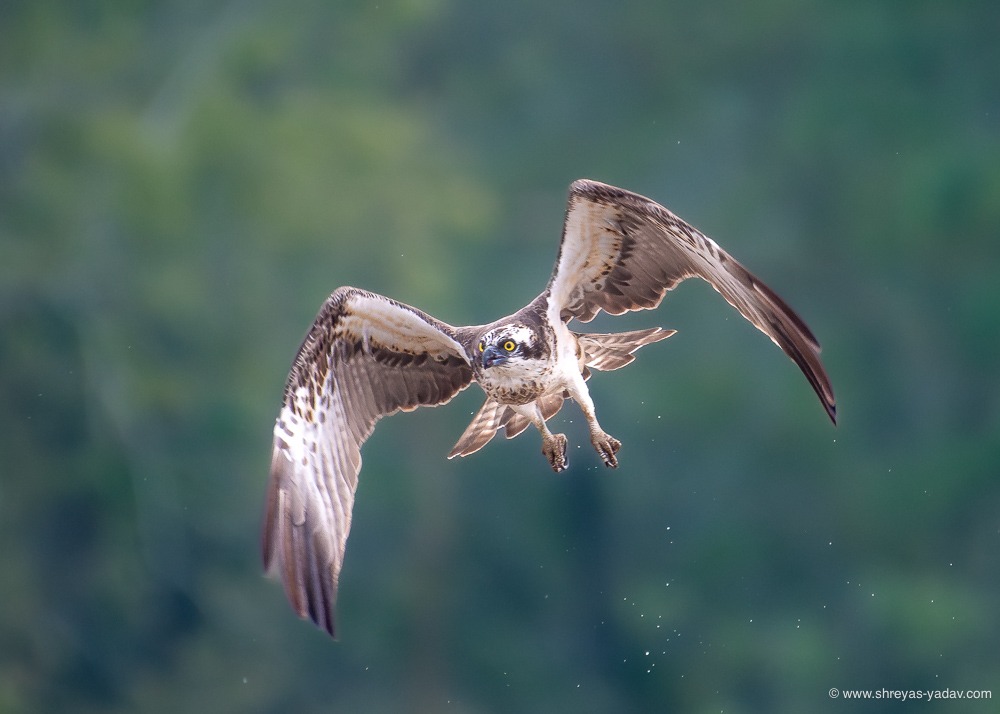
7 Tips to capture stunning Birds In Flight images
- AF Mode
- AF Area
- Shutter Speed, Aperture, and ISO
- Exposure Mode
- Frame Rate
- Using the back button focus button
- Tracking the bird
AF Mode ( Auto Focus Mode )
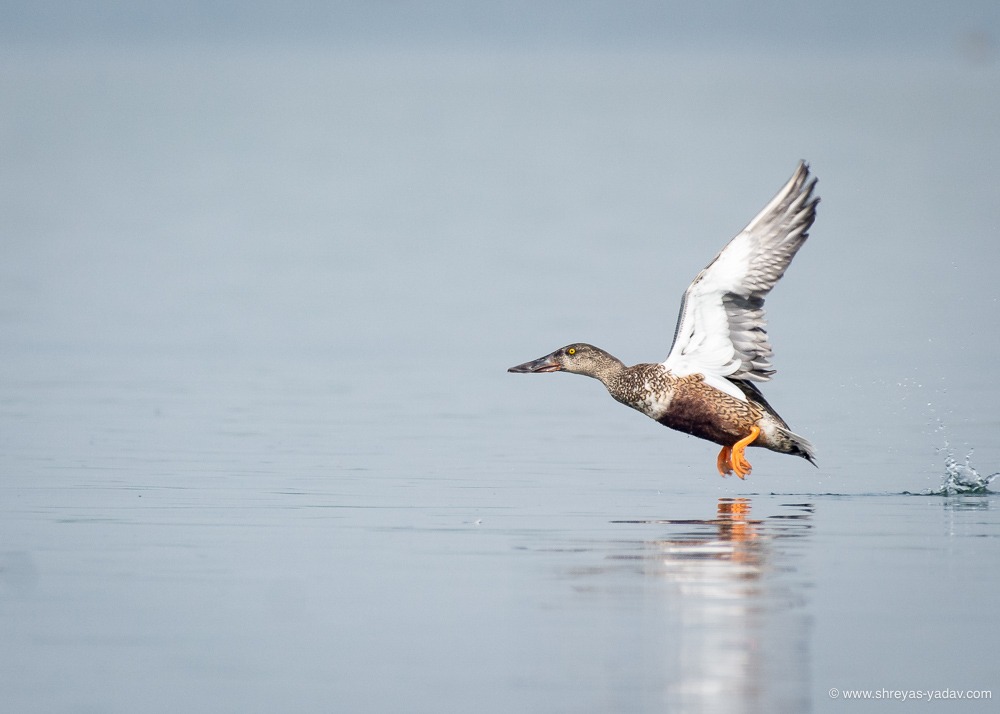
- With AF Mode, you will choose how the camera acquires the focus – Single or Continuous
- Most of the camera brands have AF modes such as AF-S and AF-C (Names can be different for different brands)
- AF-S ( AF-Single): Once you half-press the shutter release button or AF-ON button, the focus will lock on. If the subject or camera moves, the camera will not refocus on the subject. Hence, chances are your subject can go out of focus due to Subject or Camera movement. AF-S mode is good for Stationary objects and if there is no / very less camera movement.
- AF-C ( AF-Continuous ): In the AF-C option, till you keep the focus lock button pressed ( Either by half pressing the shutter release button or pressing the back button autofocus button) the camera will continuously focus on the subject. The AF-C option is good for moving subjects. As Birds in Flight are in motion, you should select AF-C ( or AI-SERVO ) mode.
- Selecting AF-C ( AF-Continuous ) focus is one of the important steps that will significantly increase your chances of getting sharp Birds In Flight images.
AF Area ( Auto Focus Area modes )
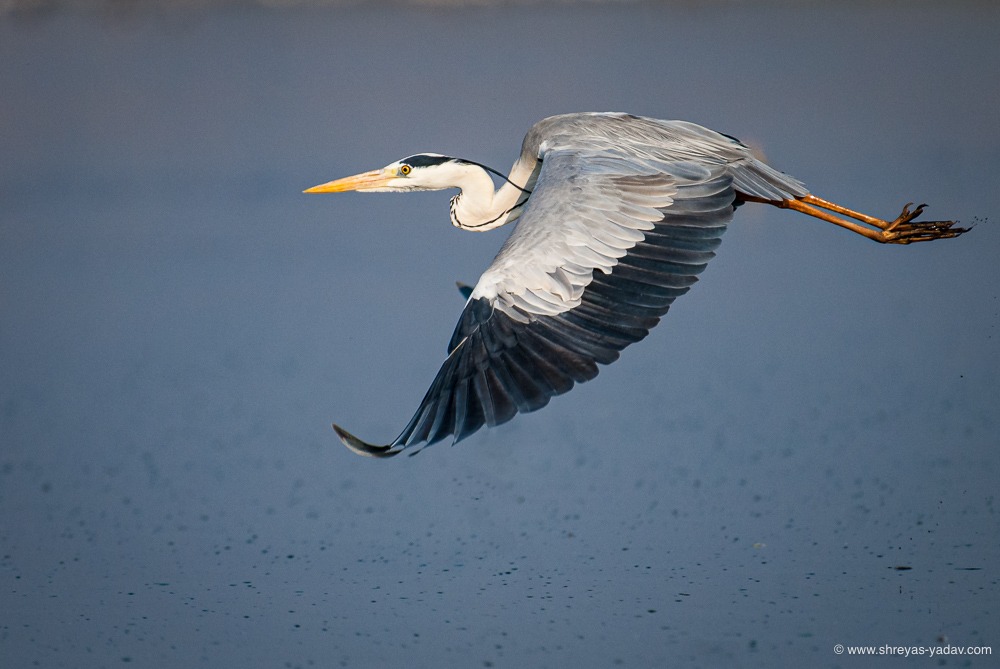
- With the AF Area option, you can control where the camera will focus.
- Set the Camera AF mode to AF-C ( AF-Continuous )
- Most of the camera brands have AF Area modes such as Single Point, Dynamic Area AF mode, 3D Tracking, Group Area AF mode, and Auto Area AF
- AF Area modes useful for Birds In Flight Photography are
- Dynamic Area AF Mode ( With 9, 25, 72, 153 points )
- In this mode, as you select the focus point, the Camera will acquire a focus on that point and surrounding points based on the point selection.
- For Example, if you select Dynamic Area AF mode with 9 Points, then if the bird moves under any of those 9 points, the camera will focus on that bird.
- The number of points are selectable in Dynamic Area Auto focus. You can select 9,25,72, 153 points.
- Typically, 9 points and 25 points work best for birds in flight. This mode is useful for Smaller to Mid-sized birds.
- Group Area Mode
- Group focus mode is comparable to Dynamic Area AF mode
- However, in Group Area mode, the points are fixed. ( Unlike to that of Dynamic area mode, where you can select 9, 25, 72 focus points )
- Generally, the Group Area Mode will have 5 points (or closer to 5 points)
- Group Area mode is useful for Birds In Flight of Mid or Larger size.
- Single Point Mode
- As the name suggests, you will have a single-point area focus. Camera will focus on the point you select- That’s it!
- Although Single point AF area mode is rarely used for Birds In Flight shots, you can use it for Larger Birds and if the Birds are closer.
- For the Birds In Flight shots, prefer to use First mode as Dynamic Area AF Mode (9 or 25 points), Second mode as Group Area Mode, and Last mode as Single Point AF mode.
- Dynamic Area AF Mode ( With 9, 25, 72, 153 points )
Shutter Speed, Aperture, and ISO
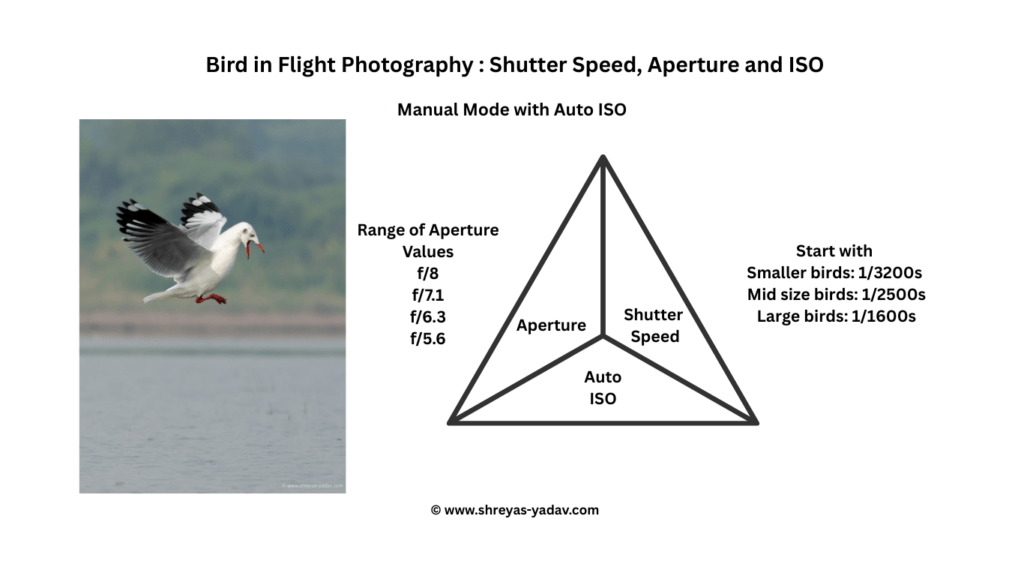
- Shutter Speed
- For Bird-In-Flight Images, Shutter speed is an important setting.
- As you want to freeze the motion of the bird’s flight, you need to use higher shutter speeds
- Here are the general starting points for shutter speeds
- For Smaller birds and fast-moving birds – 1/3200s
- For Medium-sized birds – 1/2500s
- For Larger size birds – 1/1600s
- Shutter speeds mentioned here are starting points. Depending on bird motion, wind, type of lens support, you may have to use higher shutter speeds. Also, as you practice more, you will be able to get Birds In Flight shots with lower shutter speeds than mentioned above
- As a summary, use the above shutter speeds as a starting point.
- Aperture
- Aperture will control what part of the Bird will be in focus.
- Also, the bird will be in continuous motion, hence to get a bird in focus higher aperture will be required
- f/8 is a safe starting point for Bird In Flight images. With f/8, the Depth of the field will be deep. Most of the bird will be in focus.
- However, with higher aperture, the background may not be smooth and blur. Also higher aperture value will demand a higher ISO. It may not be feasible due to light conditions and image noise.
- Hence, depending on the bird size, bird motion, and distance between Bird and the background, choose the aperture.
- Start with aperture f/8. If you are getting a good bird in flight (sharp and in focus) then start dropping the aperture slowly. Try the aperture values of f/7.1, f/6.3 up to f/5.6.
- f/8 to f/5.6 is a good range of aperture to get Bird-in-flight images.
- ISO
- ISO is important in getting higher shutter speeds. If the light conditions are not great, then in order to get usable birds in flight shots, you need higher shutter speeds. Hence, pushing the ISO to a higher value is an option.
- Pushing the ISO beyond the camera sensor’s capability will introduce significant image noise and degrade the image quality.
- Hence, depending on the light condition, the Shutter speed required choose the lowest possible ISO accordingly. Remember, the priority is to get required Shutter speed and then set the ISO that supports that shutter speed.
- For example, if your current ISO is ISO 800 and you need a shutter speed of 1/1600 s ( for this example, consider the Aperture is set to f/5.6). And the image appears dark. Which means you need to increase the ISO. You increase the ISO to ISO 1200, and you are getting a shutter speed of 1/1600s with correct exposure, resulting in a usable shot. Hence, in this case, don’t push the ISO beyond ISO 1200. ( Like ISO 1600 or ISO 2000 ). Sure, it will give you an extra Shutter speed ( which you don’t need ) and introduce Image noise( which will degrade the image quality)
- As a summary, choose the lowest possible ISO which will get you the right Shutter speed for Bird-In-Flight photography. Depending on light condition and required shutter speed choose the ISO.
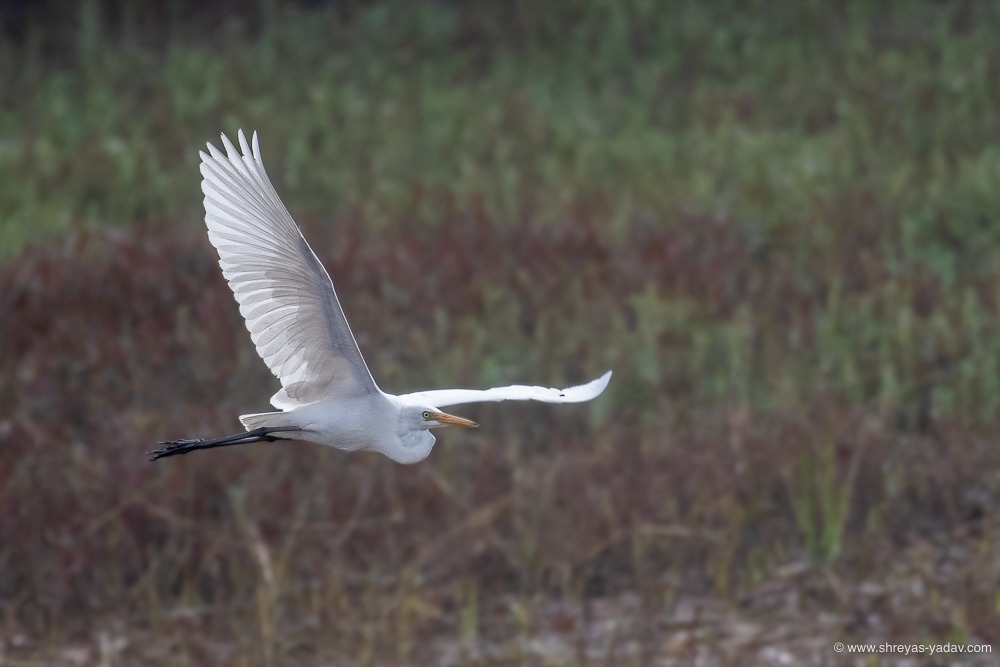
Exposure mode
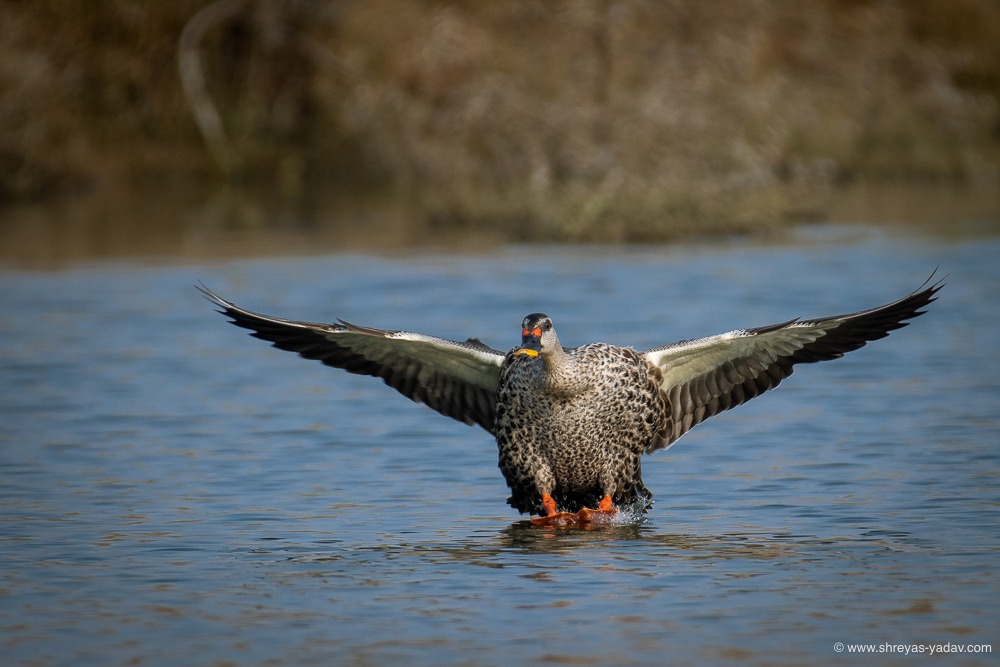
- For Bird in Flight photography, you need to control the shutter speed to freeze the moment. Also, you need to control the depth of the field to get the bird in focus.
- As Bird In Flight demands a quick response to get a perfect image. Which means you need to set the camera exposure quickly.
- Setting Manual mode with Auto ISO will help you to get the best possible exposure in the least amount of time.
- Set the Max ISO till you get usable shots. Some cameras will get usable shots up to ISO 12800, ISO 6400, ISO 3200, or some have to restrict the maximum ISO up to ISO 1600
- Depending on the size of the Bird and the movement of the bird, select a shutter speed. As mentioned earlier, select the aperture between f/8 to f/5.6. Depending on the Shutter Speed and Aperture you selected, the camera will adjust the ISO accordingly.
- Aperture priority will not be useful because you will not be able to control the shutter speed. And Shutter speed is important for Bird-In-Flight images. Also, Shutter priority may be helpful in some cases, but the camera will try to open up the Lens Aperture. It will cause a shallow depth of field. And due to the shallow depth of the field, there is a chance that Bird will be out of focus.
- Hence, select the Manual Mode with Auto ISO exposure mode for Bird-in-Flight images.
Frame rate
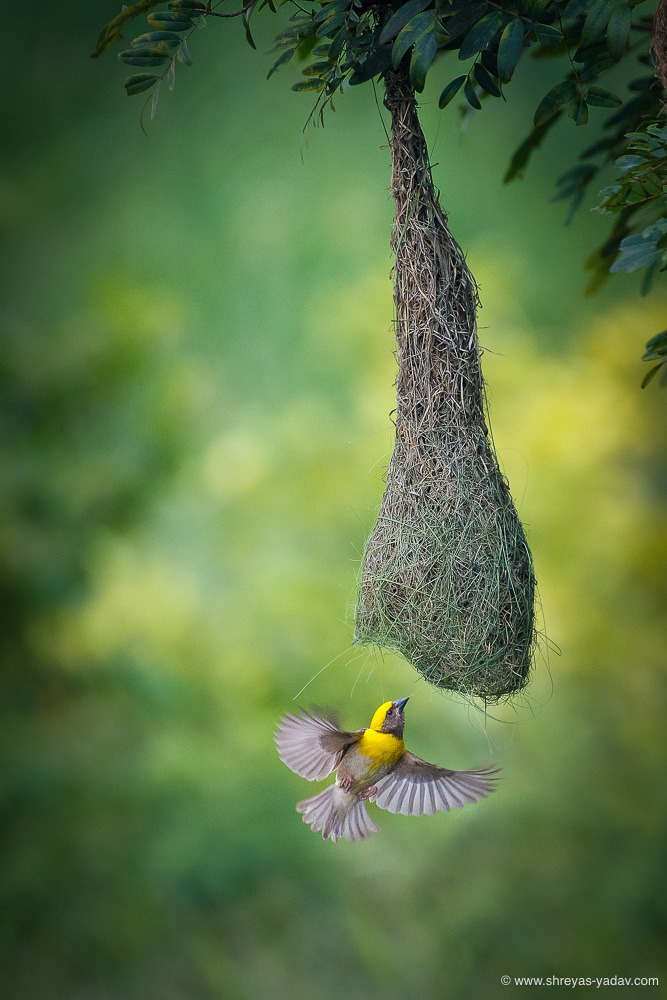
- Higher FPS: Frames Per Second gives a better success rate for Bird In Flight photography
- Higher FPS will capture more images per second. It will help to capture that Perfect Bird In Flight moment.
- Most of the cameras have a frame rate option as Single, Low, and High. Single means one Frame will be clicked per second. High refers to a Higher frame rate. Select the Highest Frame Rate that your camera has.
- Make sure you are using a Memory card that supports the higher frame rate.
- Mid to pro-level DSLR’s have a Frame rate of 7FPS to 10FPS. Whereas recent Mirrorless cameras have higher FPS, such as 20 FPS or more.
Using the back button focus button
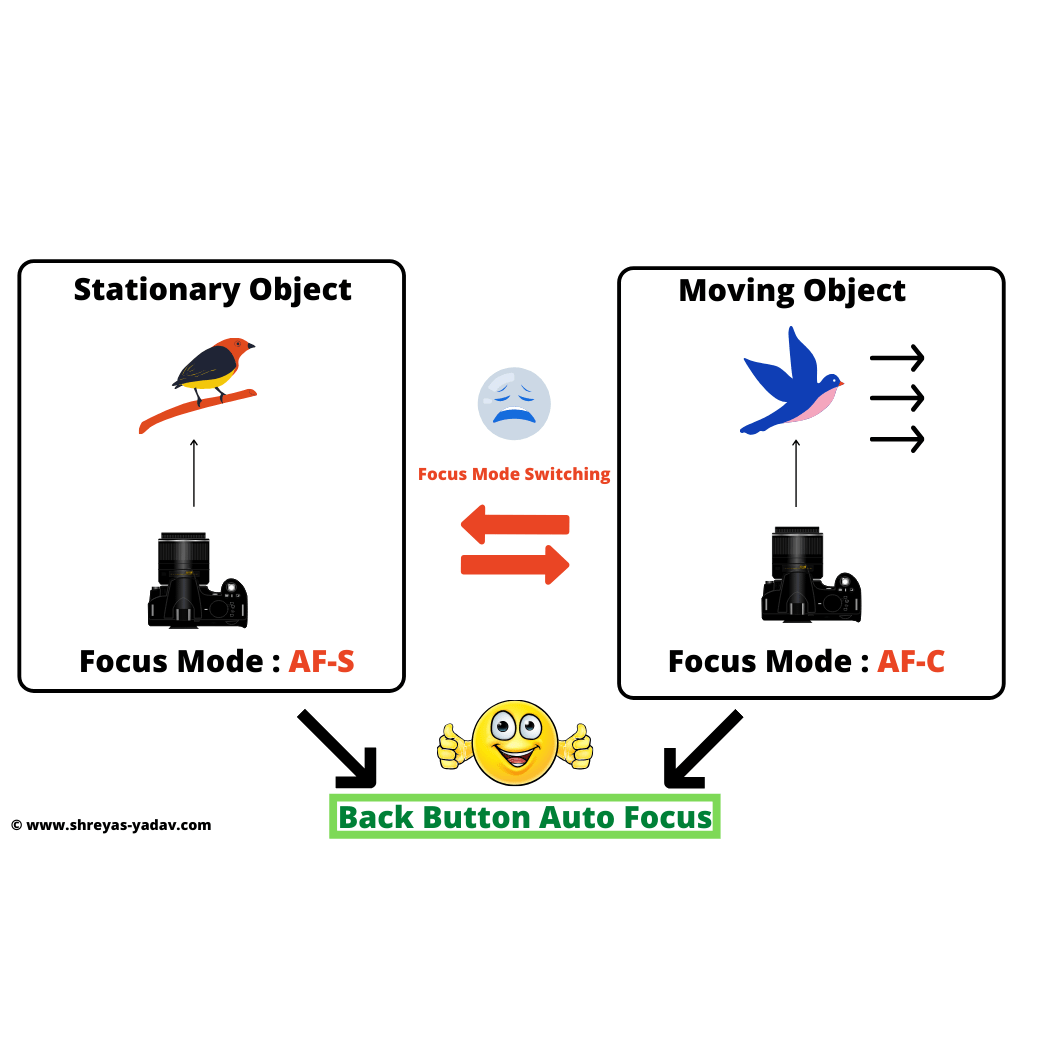
- Back button autofocus helps to switch between AF-Single and AF-Continuous Mode quickly.
- Imagine a bird is standing or perched on a tree/ rock you will use AF-Single mode to acquire the focus. As soon as the bird takes off, you need to quickly switch to AF-Continuous. Back button Autofocus is important in this type of scenario.
- Once you acquire a focus on the bird, and Back Button Autofocus is pressed, the camera will continue to focus on the moving Bird.
- Here is a detailed step-by-step guide on how to set up Back button Autofocus and how to use the Back Button Autofocus.
- Step-by-Step Guide to Back Button Autofocus: https://shreyas-yadav.com/back-button-autofocus-for-wildlife-photography/

Tracking the bird
- Generally, for Bird In Flight Photography, the Bird will be flying in front of you, the Bird flying towards you, the Bird flying towards you in a slanted direction, and the Bird hovering
- Refer below Picture for various birds in flight scenarios
- Photographing a bird hovering is relatively easy one to photograph. Since birds such as Kingfisher, black shouldered kite, and Sunbird hover at almost no change is location. You can acquire a focus, and you will get nice bird in flight shots.
- For a Bird flying towards you, keeping the focus point on the Bird will be relatively manageable. Since the Bird is flying towards you, and mostly the bird will not go out of focus areas you selected. If the camera acquires focus fast and has a higher frame rate, then you can get a good Bird In Flight Image. Shots like Bird flying towards you demand faster camera autofocus capability and higher frame rates.
- A bird flying in front of you needs to be tracked precisely. Set the Camera to AF-Continuous mode. Acquire the focus on the bird using Back Button Autofocus. Once the focus is acquired, keep the focus engaged by pressing the Back button autofocus button. Keep tracking the bird. Click the shutter release button. While clicking the shutter release button, make sure you continue to track the Bird.
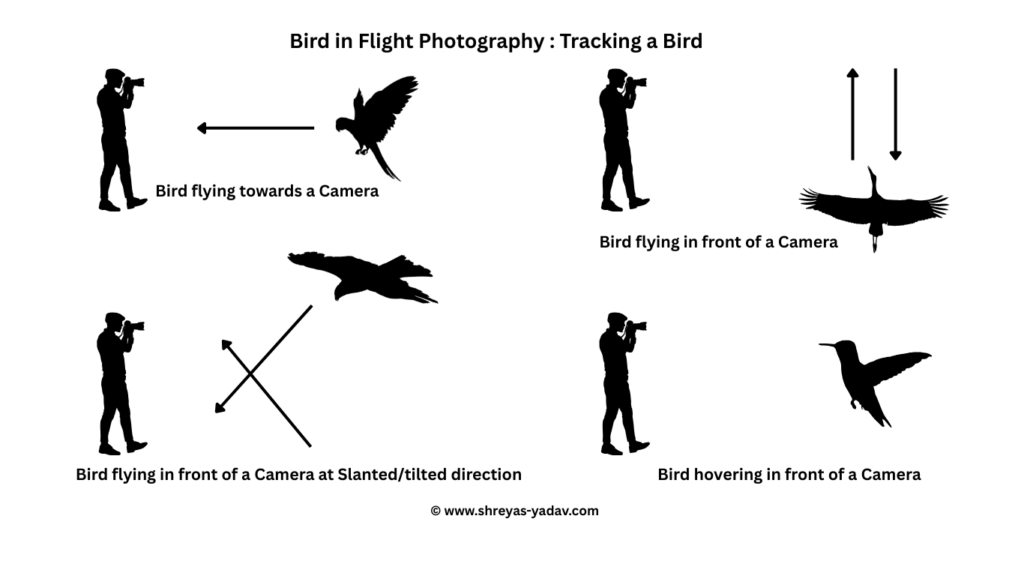

There you go! These are 7 tips that will help you capture stunning Bird-In-flight Images.
Now I would like to hear from you.
Do you find these tips helpful? Which techniques will you try first? I would love to hear that in the comments below –
EXPLORE. PHOTOGRAPH. INSPIRE
Join our newsletter for the best articles about Digital Post-Processing and Photography techniques. No charge. No Spam. Only love.
Leave a Reply